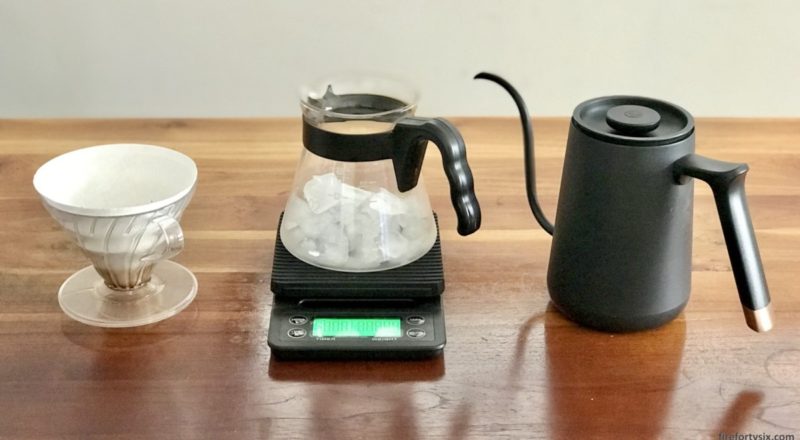I usually like to drink my coffee hot. Well, technically closer to room temperature, since I find that the taste improves as it cools down.
But on a particularly hot and sunny afternoon, I find myself craving for an ice-cold glass of black coffee. No milk, no sugar, no nothing.
And since there are basically two seasons in Singapore: hot & dry and hot & wet (sometimes, both can happen during the same day!), that happens quite frequently.
I suppose I could make my usual pour over brew more concentrated than usual, and then dump the hot coffee into a cup of ice cubes.
But there’s a more elegant and efficient way; a way that the Japanese have been doing for ages.
Just brew the coffee directly onto ice cubes.

I decided to use my trusty Tetsu 4-6 recipe, with some tweaks of course.
Most Japanese iced coffee recipes suggest replacing 1/3 of the water volume with ice, and since I usually brew with 400gm of water, I’d have to use 270gm of hot water and replace the remaining 130gm with ice in the server.
The first 40% of Tetsu 4-6 (i.e. 160gm) can be poured as normal, with the choice of using the Standard, Sweet or Bright settings depending on the bloom amount.
The second 60% is truncated, since there’s only 110gm of hot water left to pour, effectively making it the Medium setting but with one less pour.
In summary:
- 25gm coffee : 130gm ice : 270gm hot water (1 : 5 : 11 ratio)
- For Sweet (Bloom 2x) setting, first pour 50gm hot water
- Second pour another 110gm hot water (for total of 160gm), starting at 0:45
- Final pour remaining 110gm hot water (for total of 270gm), starting at 1:30
- Total brew time should be around 2:30, plus or minus
The Finca Santa Teresa Batista by Parallel Coffee Roasters was the open bag that afternoon; a delicate Panama Gesha that was light and tea-like. Perhaps making Japanese iced coffee using those beans would result in a delicious iced tea?


The hot version that I had that morning reminded me surprisingly of chin chow, a herbal grass jelly drink common in Singapore. The iced version, unfortunately, had less flavour and was clearly missing depth and body.
It was probably not the right bean for iced coffee and definitely tasted better hot. Something more robust would have probably fared better, and I’ll have to try again with a strong and fruity Ethiopian next time.
Having said that, it was still a nice cold glass of coffee; a perfect drink for a hot sunny afternoon.



Do you find the need to grind the coffee finer, in order to get more contact time and surface area, which would hopefully result in a stronger extraction with less water contact?
I didn’t grind finer for this batch, but will definitely have to do so the next time I make it.